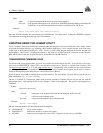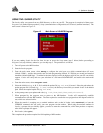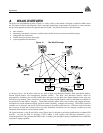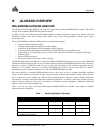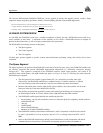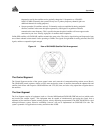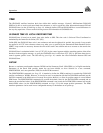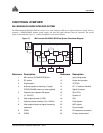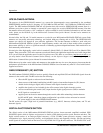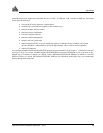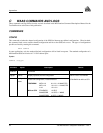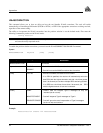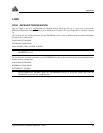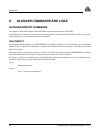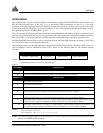
Appendices
28 Test Bed Receiver Subsystem Addendum – Rev 1
GPS/GLONASS ANTENNA
The purpose of the GPS/GLONASS antenna is to convert the electromagnetic waves transmitted by the combined
GPS/GLONASS satellites at the L1 frequency (1575.42 MHz for GPS and 1602 - 1615.5 MHz for GLONASS) into RF
signals. The MiLLennium-GLONASS GPSCard will function best with an active GPS/GLONASS antenna; there is a
hardware provision to select an internal or external DC power supply for an active GPS/GLONASS antenna. Note that
the antenna self-test will return a “fail” condition if a passive antenna is used (for further information on self-test status
codes, please see the RVSA/B log in the MiLLennium Command Descriptions Manual. NovAtel active antennas are
recommended.
NovAtel offers the 504 and 514 model antennas to work with your MiLLennium-GLONASS GPSCard system. Both
antennas use low-profile microstrip technology and include band-pass filtering and an LNA. The GPS/GLONASS
antenna you choose will depend on your particular application. The NovAtel antennas available to work with your
MiLLennium-GLONASS GPSCard system are single-frequency models, and each of these models offers exceptional
phase-center stability as well as a significant measure of immunity against multipath interference. Both models have an
environmentally-sealed radome.
NovAtel also offers high-quality coaxial cable in standard 5 (Model C005), 15 (Model C015) and 30 m (Model C030)
lengths. These come with a TNC male connector at each end. Should your application require the use of cable longer than
30 m you will find the application note Extended Length Antenna Cable Runs at our website, http://www.novatel.ca
, or
you may obtain it from NovAtel Customer Service directly, see the Software Support section at the beginning of the
MiLLennium Command Descriptions Manual for contact information.
While there may be other coaxial cables and antennas on the market that may also serve the purpose, please note that the
performance specifications of the MiLLennium-GLONASS GPSCard are warranted only when it is used with NovAtel-
supplied accessories.
RADIO FREQUENCY (RF) SECTION
The MiLLennium-GLONASS GPSCard receives partially filtered and amplified GPS and GLONASS signals from the
antenna via the coaxial cable. The RF section does the following:
• filters the RF signals to reduce noise and interference
• down-converts (with further band-limiting) the RF signals to intermediate frequencies (IFs) that are
suitable for the analog-to-digital (A/D) converter in the digital electronics section
• amplifies the signals to a level suitable for the A/D converter in the digital electronics section
• receives an automatic gain control (AGC) input from the digital signal processor (DSP) to maintain
the IF signals at a constant level
• supplies power to the active antenna through the coaxial cable while maintaining isolation between
the DC and RF paths. A hardware jumper configuration is provided to select an internal or external
DC power supply for the active GPS/GLONASS antenna.
The RF section can reject a high level of potential interference (e.g., MSAT, Inmarsat, cellular phone, and TV sub-
harmonic signals).
DIGITAL ELECTRONICS SECTION
The digital section of the MiLLennium-GLONASS GPSCard receives down-converted, amplified combined GPS/
GLONASS signals which it digitizes and processes to obtain a GPS solution (position, speed, direction and time). The
digital section consists of an analog-to-digital converter, a 32-bit 25 MHz system processor, memory, control and
configuration logic, signal processing circuitry, serial peripheral devices, and supporting circuitry. I/O data and timing
strobe signals are routed to and from the board via a 64-pin DIN 41612 Type B male connector. Two EIA RS-232C serial



